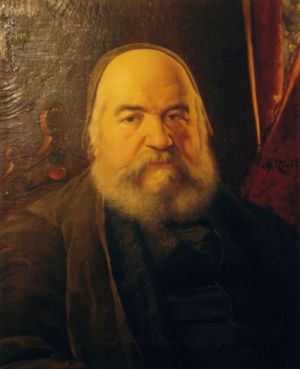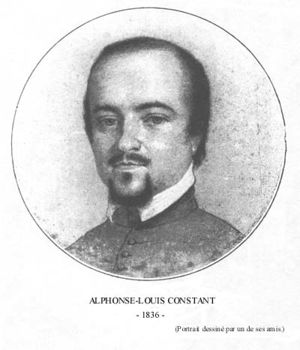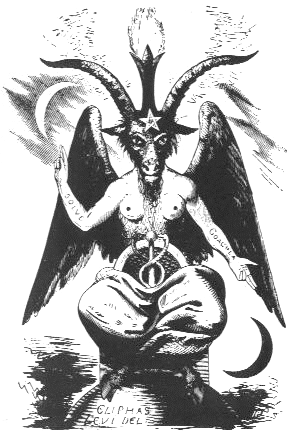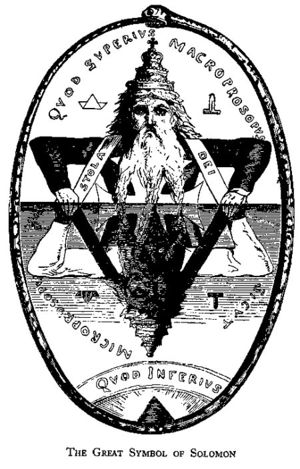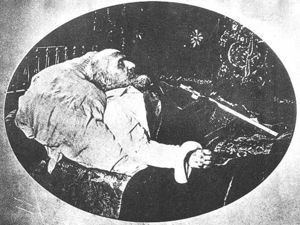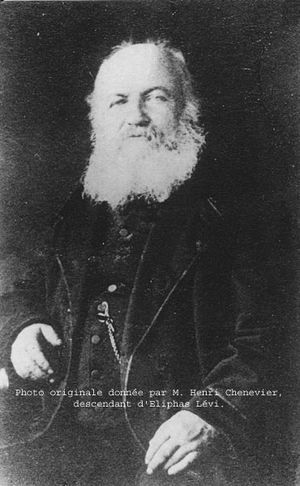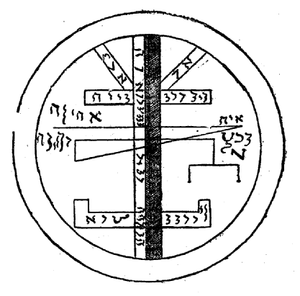Éliphas Lévi
Éliphas Lévi, also Éliphas Lévi Zahed was the pseudonym used by the Catholic cleric Alphonse-Louis Constant (February 8, 1810, Paris - May 31, 1875, ibid.) to write and publish scripts of occult and magical contents from 1854 on. Lévi is said to have re-established occultism in the 19th century.[1]
Life
Per aspera ...
Constant's father was a shoemaker in Paris. Although the material conditions of his family were rather limited, Constant attended a school for the poor free of charge run by a parish and was able to attend a seminary. Ordained as a sub-deacon in 1835, he was entrusted with teaching assignments. Since he fell in love with one of his pupils (whom he thought to be a reincarnation of the Virgin Mary), he left the seminary prior to the ordination to priesthood. The relationship, however, failed shortly after this.
Disappointed with him leaving his education, Constant's mother committed suicide a few weeks later. Constant then saw a period of erratic quest. Within the following year, he made the acquaintance of Honoré de Balzac, befriended militant socialist Flora Tristan, and yet still dreamt of a future as a priest. This dream took him to St. Peter's Abbey, a Benedictine monastery in whose library of 20,000 volumes he became acqainted with scripts from early Christianity, by ancient gnostics, as well as the works of religious mystics. It was there he authored his first book "Le Rosier de Mai" which was as pious as it was romantic, but at the same time enthused about matters of love in such fancyful and vivid ways he was expelled from the monastery.
Since the archbishop of Paris, Denis Auguste Affre, interceded on his behalf, Constant received an appointment as a supervisor at Juilly College east of Paris. Treated badly by his seniors, he wrote his first furious pamphlet, La Bible de la liberté. Its publication in February 1841 not only caused a scandal within the church hierarchy, but also at the court in Versailles.[2] Constant was arrested and sentenced to a prison term of eight months and a fine of 300 Francs. Unable to raise this sum, he served eleven months in prison, studying the works of Swedish mystic Emmanuel Swedenborg.
After Constant's discharge bishop Affre recommended him to his colleague in Évreux[3], where from February 1843 on he preached in so successful a way that his fellow ministers jealously announced the death of abbé Constant in the newspapers. Despite a swift denial another scandal couldn't be avoided, however, the bishop kept his hand upon him, and commissioned him with the realisation of a mural painting in a nunnery. Rumour has it that at about the same time he nearly became a member of the secretive Rosicrucian Order. Friends of his father's vouched for him, by which he might even have prospects of the rank of a Grand Master. Unfortunately nothing of that came about, and the painting too would not be finished. Because when in 1844 his second sweeping blow appeared, La Mère de Dieu, his relationship with the bishop experienced a rapid deterioration, and Constant returned to Paris.
Deeply churned up by the death of his friend Flora Tristan he published L'Émancipation de la femme ou le Testament de la paria, followed a year later (1845) by his pacifist manifesto La Fête-Dieu ou le Triomphe de la paix religieuse. After all, he occupied himself busily with the humanistic and the utopian ideas of the time, particularly Saint-Simonianism and the theories of Charles Fourier. But neither could convince him: Saint Simon teaches religion without religiousness, which he found repulsive. And Fourier's approach of man's necessity for acting out his drives he considered absurd and foolish. He was 35 now, and still his search continued.
It is not very much astonishing that his private affairs weren't running smoothly either.[4] In the small town Choisy-le-Roi, located a few kilometres outside of Paris and since 1840 at the railway to Orleans, he used to meet with a warden of a girls' school (presumably, see note). But while they were making plans to marry, and she was pregnant from him, one of her girl friends fell in love with Alphonse, the underage maiden Marie-Noémi Cadiot. Some fiery love letters later she escaped and hid herself in his garret. Seeing himself put before the choice between marrying her or face trial for seducing a minor - what was left for him? On July 13, 1846, they married. She gave birth to a daughter whom he adored and who would die aged seven in 1854. Soon after which Marie-Noémi would leave him. The descendants of the warden he left so unfaithfully live to this very day.
The revolution of February 1848 brought more liberties for Alphonse-Louis too. Just one year ago he had once more been convicted for one of his pamphlets, La Voix de la famine, now nothing could hamper his roaming the political stage any longer. He headed the left-wing magazine Le Tribun du peuple which died after the fourth issue, founded a political workers' association named (in revolutionary tradition) Le Club de la montagne[5], then in June, when the political reaction felt uneasy about the latest developments and tried to turn back the wheels, he nearly got killed by a firing squad. Luckily they took someone else for him and shot the wrong fellow. He tried to be elected to the National Assemply, but a friend of his made the race, after which the friendship broke. Under financial aspects however the couple Constant was well off now, because Marie-Noémi was emancipating herself. She published literary feuilletons, and received lessons from the sculptor James Pradier who had already been promoted by the Roi Citoyen and now helped her open the doors to the Parisian society. In this wake of hers Alphonse too was commissioned by the government with two paintings for the ministry of the interior.
... ad occultum
Is it allowed to judge a person, having come to know so little about him and in so compact a way? Maybe not, but one may have an impression of him, and this one may express. And if now, in 1850, Alphonse-Louis Constant were confronted with the notion that for all intents and purposes his life so far had been stranded he would flatly deny such a view, apalled perhaps and blustering, and yet all the while secretly suspecting that so completely wrong the thought might not have been. Because, what had he achieved as yet? His theological and (church) political scriptures had earned him not much more than troubles and the inconveniences of the penal system, his pastoral career wasn't worth much talking about, his political engagements remained without success, and all his artistical pursuit kept being a hobby-horse rather, if at all. One can imagine that all of this was beginning to prey on his mind.
But through all these years there existed another thread, woven into the fabric of his life. It started during his stay at Solesmes (1838-39), was spun a little longer by the convict's study of Swedenborg in 1841, nearly became extended with the almost achieved degree of Grand Master to the Rosicrucians at Evreux, strengthened itself just lately (1850/ 51) during a study of Rosenroth's Kabbala denudata, and now at last became visible for Alphonse himself as leitmotiv and anchor for his further life: mysticism, theosophy, in general the occult knowledge. He recalled the name Éliphas Lévi Zahed, once bestowed on him by the Rosicrucians and allegedly representing a translation of his name into Hebrew,[6] and chose it for his pseudonym. About this time he started the composition of his later opus magnum Dogme et rituel de la haute magie. He had found his way.
In spring 1854 Lévi went on a journey to London where he made the acquaintance of the in his days famous writer Edward Bulwer-Lytton. Over their common interest in the occult they became friends.[7] Through Bulwer-Lytton's influence he came once more in contact with Rosicrucian circles, there he succeeds in several evocations, the most outstanding of which was that of Apollonios of Tyana.[8] During the London times his private affairs too came to an amicable settlement: the young woman he left in Choisy-le-Roi forgave him, and he accepted the illegitimate child as his own. At the same time Marie-Noémi left their common residence.
Back in Paris, he in 1854 published the first volume of Dogme et rituel de la haute magie. His intensive occupation with the Kabbala he documented in a number of essays, all of which he published in the Revue philosophique et religieuse, a periodical he founded in 1855 together with the Belgian writer Camille Lemonnier and the French philosopher Charles Fauvety, and which they co-productively managed over the three years of its existence. For his diversion he wrote a couple of chansons. In one of these he compared Louis Napoléon Bonaparte, meanwhile emperor Napoléon III, with Caligula. That - we know him by now - earned him another term in prison. (Anyway, some of the chansons he managed to place in Le Mousquetaire, a magazine Alexandre Dumas published at that time.)
Then in 1859, at long last (he was 49 years old now), the economical breakthrough: the publication of his History of Magic brings a return of 1,000 Francs, at today's purchasing power an equivalent of more than 30,000 Euros. But l'Histoire de la magie isn't just the economical success, it also gets him recognition in wide sections of the "esoteric" France, among them the physician Fernand Rozier who would become a student of Lévi's.[9] Eventually in March 1861 he was accepted in the Masonic Lodge La Rose du parfait silence who soon after grant him the degree of a Master. In the same year La Clef des grands mystères appears, last part of the trilogy that starts with Histoire de la magie and of which Dogme et rituel de la haute magie was conceived the second part.
Lévi works a lot now, mainly as teacher for the high aristocracy, and that he even teaches the new bishop of Évreux[10] on the kabbalah does speak for his professional reputation. He is doing well financially, every surplus he invests in his growing library. During a further visit to London Eugène Vintras is introduced to him, a workingman who is convinced of being a reincarnation of the prophet Elijah. Lévi on the contrary, all expert now, considers him more a gifted psychic, an interesting object of study anyway. This same year marks the start of a correspondence with the Italian baronet Spedalieri, about whom nothing seems to have been passed on to us except that he became Lévi's most important patron and in reverse received in over 1,000 letters a course on the kabbalah. This exchange of letters lasted for almost thirteen years.
The years beginning with 1861 are the most fruitful for his authorship. Le Sorcier de Meudon (1861) is followed one year later by Fables et symboles, containing extensive analyses of the symbolisms of Pythagoras, of the gospels, the talmud, and other sources. In 1865 he publishes Science des esprits, and Pierre Larousse asks him to contribute an essay on the kabbalah for his Grand Dictionnaire. At the same time he starts working on a monograph about the Zohar, however this work won't be published until after his death.[11]
His private life, however, is running less pleasantly meanwhile. Sure, he makes up his mind to care more for his son, and gets the mother's approval for it, but after six years an ultimate discord drives the parents apart, and neither his son nor the mother he shall ever see again. Adding to this, headaches arise, tormenting him more and more frequently. Then in 1870 the siege of Paris cuts off all contributions from his students, and when he serves in the National Guard a heart disease manifests. In May 1861, with the episode of the Commune finally being over, Lévi once again finds himself at the end of all material resources.
Although he still continues working (in December 1871 already he completes the Grimoire franco-latomorum on rites of the French freemasons), but his physical status deteriorates increasingly. His heart disease repeatedly causes him to faint - he were not the one he is, of course, would he not report of ecstatic visions during his blackouts. But the path of life he had found only so late he cannot leave: in 1873 L'Évangile de la science comes into existence, followed by the Catéchisme de la paix in January 1875, the last of his works. He wrested it from his life (or was it already death?), fighting against chronic bronchitis, permanent fever, water retention in the legs, and recurrent shortages of breath. On May 31, 1875 Éliphas Lévi dies at the age of 65.
Review
How crooked, bumby, and tangled the way of Lévi's life may appear, yet it always followed one goal: social advancement, and the recognition in society that would hopefully come with it. Young Alphonse was a promising boy, that his way in school proved clearly right. In France during the age of restauration the direction towards a clerical vocation promised with certainty a future where he would be able to leave the petit-bourgeois milieu of his ancestors, and to live a life secured financially as well socially. For how large his parents' hopes had been his mother's suicide is an eloquent mark. That at least they were not unjustified one may read from the Parisian archbishop's commitment on Alphonse's behalf.
The effects his mother's suicide and the reproach connected to it had on Constant may merely be surmised. One cannot reject though the notion that both didn't help stabilize his connections with other people. The only friend he would ever have throughout his life, Flora Tristan, died too early. Both his marriage, and the relationship with the mother to his son ended in discord. He is a lonely chap, one can't help thinking. Lots of people cross his paths, but not from one of these encounters a stable, level relationship manages to emerge. It appears he deliberately kept himself distant, in the superior position of the teacher, the other-worldliness of a medium, the posture of knowingness about the unreachable, the occult. This may have been calculated as belonging to the chosen role. But it seems that only one of his relationships turned out stable and long lasting: the one with Baronet Spedalieri, with its twofold distance of geography and that between teacher and student.
These two aspects fall into place to form a picture: There is, rooted deeply into him during his childhood, the desire for social advancement, for recognition and importance, and there is that ultimate gesture of boundless condemnation for his betrayal of this goal, his mother's suicide. Her accusation derails him for a long time, he will suffer visibly, all his activities during the following years becoming a trifle too noisy, too conspicuous, too much begging for effect - as if of someone being plagued by a bad consciousness that nobody ever must notice. Only the next mighty blow to come, the death of his daughter in 1854, puts a limit to this compulsion - albeit for a high price: Under the impression of this latest loss he accepts his mother's old reproach. Loneliness becomes the chosen punishment for his guilt, and in the drive to overcome both guilt and punishment arises the momentum for the rest of his life. From now on he will write in order to free himself. He will not realize that relief lies exclusively in himself, because it was he who accepted that guilt in the first place. And the more he is going to write, the deeper this one and only realistic chance of exoneration will sink back into the occult, and the deeper he will dig into the arcane - without ever hitting what he is actually looking for.
Reception
In the Paris of the Second Empire Éliphas Lévi was a well known person. In the beginning a rather casual interest, his pursuit of esoteric matters later earned him a singular knowledge, almost tailor-made for a society that could no longer believe in the solacements from the church, yet neither in those the ersatz religion science would offer[12]. Although the political revolutions which had been turning the French society literally upside down for six decades finally found a temporary slowdown under Napoléon III, neither his imperialistic foreign policy nor the pomp of his self-stagings could resolve the deeply rooted feeling of uncertainty. People sensed something had been lost, and albeit only a small minority actually wanted to turn back the clock there was a widespread, diffuse longing - for a modern past, for a "like back then, but today". Esotericism appeared to offer a solution of this dilemma. By applying methods and forms of representation of the natural sciences on conceptions of the supernatural a connection between these two seemingly emerged, and the occult sciences took shape.
One reason for Éliphas Lévi's success may of course be seen in the fact that he was the first who consequently followed this path. He was the first after Agrippa von Nettesheim who occupied himself with occultism more intensely than just en passant. That way he could draw from an extensive well - without being hampered by the lesser developed ability in him to working systematically. Almost every notable mystic of the following times would be influenced by his scriptures, for the wide range of subjects they cover as well as for their relative originality. His taste for excentric appearances, calculated for effect and regardless of possibly negative outcome, helped boost his popularity even further. Seven years after his death the Parisian newspaper Le Figaro would publish a leading article about him.[13]
Apart from the above-mentioned Fernand Rozier the mystics particularly influenced by him were:
- Gérard Encausse (1865 - 1916), who published under the pseudonym Papus,
- Stanislas de Guaita (1861 - 1897),
- Joséphin Péladan (1858 - 1918), who called himself Sâr Mérodack Joséphin Péladan.
In the English language area he reached amongst others:
- Helena Blavatsky (1831 - 1891),
- H.P. Lovecraft (1890 - 1937),
- Aleister Crowley (1875 - 1947), who considered himself a reincarnation of Lévi.
Works
After having chosen Éliphas Lévi for his pseudonym he no longer published under his original name. With regards to contents a similarly clear distinction can be observed: works of theosophical/ occult contents are written exclusively "by" Éliphas Lévi; for the political pamphlets and the Dictionnaire de la littérature chrétienne Alphonse-Louis Constant signs as their author.
Alphonse-Louis Constant
| 1839 | Le Rosier de mai |
| 1841 | La Bible de la liberté |
| L'Assomption de la femme ou le Livre de l'amour | |
| Doctrines religieuses et sociales | |
| 1845 | La Fête-Dieu ou le Triomphe de la paix religieuse |
| Paix! Paix! Réprimande adressée par un abbé et un théologien à Timon qui n'est ni l'un ni l'autre | |
| Le Livre des larmes ou le Christ consolateur, Essai de conciliation entre l'Église catholique et la philosophie moderne | |
| Les Trois Harmonies | |
| 1846 | La Dernière Incarnation |
| La Voix de la famine | |
| 1847 | Le Deuil de la Pologne. Protestation de la Démocratie française et du Socialisme universel |
| Rabelais à la Basmette | |
| Les Trois Malfaiteurs | |
| Le Sorcier de la Devinière | |
| 1848 | Two Chansons: La Marseillaise du peuple und Le Règne du peuple |
| Le Testament de la liberté | |
| 1851 | Dictionnaire de la littérature chrétienne |
| unknown | La Bible de l'humanité[14] |
Éliphas Lévi
| 1854 | Dogme et rituel de la haute magie, Tome 1: Dogme |
| La Clavicule universelle des clavicules de Salomon ou le Grimoire des Grimoires (published posthumously) | |
| 1856 | Dogme et rituel de la haute magie, Tome 2: Rituel |
| 1856 et seq. | Carnet de notes (published posthumously) |
| 1860 | La Clavicule prophétique des sept esprits de Jean Trithème (p.p.) |
| 1861 | Histoire de la magie, avec une exposition claire de ses procédés, de ses rites et de ses mystères. Paris: Germer-Baillère, 1861[15] |
| La clef des grands mystères suivant Hénoch, Abraham, Hermès Trismégiste et Salomon. Paris: Germer-Baillère, 1861. | |
| Le sorcier de Meudon. Paris: Librairie nouvelle, 1861 | |
| 1861 ff. | Cours de philosophie occulte. Lettres au baron Spedalieri (until Feb. 1874, p.p.) |
| 1862 | La philosophie occulte. Fables et symboles, avec les explications. Paris: Germer-Baillère, 1862/ 63 (2 Bde.)[15] |
| 1863 | Appel de la Pologne à la France par un Polonais |
| 1864 | La science des esprits. Paris: Germer-Baillère, 1864[15] |
| 1868/ 69 | Le Grand Arcane ou l'Occultisme dévoilé. Paris: Chamuel, 1898 (p.p.) |
| 1869/ 70 | Le livre des Sages. Paris: Bibliothèque Chacornac, 1912 (p.p) |
| 1870 | Les Éléments de la Kabbale (p.p.) |
| 1871 | Les Portes de l'avenir ou les Dernières Paroles d'un voyant (p.p.) |
| Le Grimoire franco-latomorum (p.p.) | |
| 1872 - 74 | Le Voile du temple déchiré (p.p.) |
| 1873 | L'Évangile de la science (p.p.) |
| La Religion de la science (p.p.) | |
| Les Paradoxes de la haute science (p.p.) | |
| 1874 | La Sagesse des Anciens (p.p.) |
| Le Livre d'Abraham le Juif retrouvé (p.p.) | |
| 1875 | Le Catéchisme de la paix (p.p.) |
| unknown | Clefs majeures et clavicules de Salomon. Paris, 1895[16] |
| unknown | Le Livre d'Hermès restitué et expliqué par Éliphas Lévi et commenté par Éliphas Ben Zahed |
| unknown | L'Annexe de Salomon |
References
- ↑ l'Estoile, Arnaud de: Qui suis-je? Éliphas Lévi. Grez-sur-Loing: Pardès, 2008.
- ↑ A contemporary, if rather sardonic report of these incidents and of the following may be seen at: Mystères galans des théâtres de Paris. Paris: Cazel, 1844. Page 88 et seqq.
- ↑ Nicolas-Théodore Olivier
- ↑ The events in Constant's life described in this paragraph ought to be taken cautiously. Because when writing on this article the author got the impression that most of what can be found about Constant in the internet has been copied from the same source. Everyone for example notes a so-called "Institution Chandeau" in Choisy-le-Roi. However, even a lengthy research over several hours didn't reveal any information on that institute, but lots and lots of identical wordings, all of them apparently taken from the French Wikipedia (http://fr.wikipedia.org/wiki/Éliphas_Lévi). Chandeau is, as might be expected, a proper name, but nowhere is it mentioned with even a geographical connection to Choisy-le-Roi. Only one hint could be found: if "Institution Chandeau" is supposed to have been the name of a girls' school at the time in question, http://fr.topic-topos.com/ecole-emile-zola-choisy-le-roi might give at least a vague possibility for an explanation.
- ↑ In the first National Assembly in 1791 the deputies of the political left were seated on the upper ranks, hence the name La montagne ("Mountain Party").
- ↑ That is, however, a rather questionable "translation". The name Alphonse roots in Germanic, although so far its origin couldn't be fully established. But Eliphas was as a matter of fact the son of Esau, this much for the saving of the Rosicrucians' honour.
- ↑ Bulwer-Lytton met in his fictional works the disposition of his times for the magical and super-natural, as well as the interest in archaeological discoveries. Both he knew to wrap up in thrilling stories which made him a well esteemed author in the salons of the bourgeosie, especially with the women. His late novel The Coming Race inspires adherents of the theory of Nazi UFOs up to the present day.
- ↑ Unfortunately the English Wikipedia contains no corresponding entry.
- ↑ Rozier had studied not only medecine, but pharmacy, chemistry, and physics as well. That couldn't prevent him from financially salubrious performances as clairvoyant.
- ↑ Supposed the date is correct that was Jean-Sébastien Devoucoux who had headed the Évreux diocese since 1858. For a complete list of bishops see here: http://fr.wikipedia.org/wiki/Liste_des_évêques_d'Évreux
- ↑ http://gallica.bnf.fr/ark:/12148/bpt6k56839792/f107.image - This source claims that at the time in question he acted also as "head" of a society of "Grand Magicians". As a matter of fact that document is a belated apology of the Marian apparition at La Salette, 1846. Hence its objectiveness is rather dubious.
- ↑ What sounds polemical in fact is not. It took us over 100 years (until after Chernobyl) until eventually we managed to free science from the nimbus the 19th century had bestowed upon it.
- ↑ Un maitre sorcier. Le Figaro v. 6. Oktober 1882 (describes in detail the incidents around Lévi's near execution in 1848)
- ↑ found in: Dictionnaire des pseudonymes, Paris, 1887. p. 461
- ↑ 15.0 15.1 15.2 Information taken from: Manne, Edmond-Denis: Nouveau dictionnaire des ouvrages anonymes et pseudonymes. Lyon: Scheuring, 1868
- ↑ Taken from: Le Monde occulte Nr. 5-6. Paris, 1903. Possibly erroneous, see 1854
Versions of this article in other languages
- Deutsch: Éliphas Lévi
